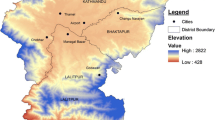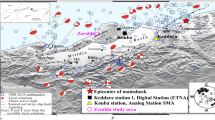Abstract
This paper presents the three most important aspects of seismic microzonation namely prediction of fundamental frequency (F 0) of soil deposit, aggravation factor (aggravation factor is simply the extra spectral amplification due to complex 2D site effects over the 1D response of the soil column) and the spatial variability of the ground motion caused by the basin-edge induced Love waves. The predicted F 0 of single, double and three-soil-layered models revealed that the available empirical relations to predict the F 0 of layered soil deposits are inadequate. We recommend the use of analytical or numerical methods to predict such an important parameter based on wave propagation effects. An increase of amplitude of Love wave, strain level and average aggravation factor (AAF) with increase of impedance contrast was obtained. Based on the trend of rate of decrease of AAF and maximum strain with offset from the basin-edge, we can qualitatively infer that the effects of induced Love wave may reduce to a negligible value after a traveled distance of 6.5–10.0 λ F (where λ F is the wavelength corresponding to the F 0 of soil layer). The obtained increase of strain level with the decrease of distance between two receiver points used for the computation of strain reflects that structures having spatial extent smaller than the λ F may suffer damage due to the basin-edge induced surface waves. The fast rate of decrease of strain with the offset from the strong lateral discontinuity (SLD)/basin-edge may be attributed to the dispersive nature of Love wave. We can incorporate the increased spectral amplification due to the induced surface waves in the form of aggravation factor but till date we have no effective way to incorporate the effects of developed strain by induced surface waves in seismic microzonation or in building codes.
Similar content being viewed by others
References
Bard P-Y and Bouchon M 1980 The seismic response of sediment-filled valleys. Part 1. The case of incident SH waves; Bull. Seismol. Soc. Am. 70 1263–1286.
Chavez-Garcia F J and Faccioli E 2000 Complex site effects and building codes: making the leap; J. Seismol. 4 23–40.
Clayton R W and Engquist B 1977 Absorbing boundary conditions for acoustic and elastic wave equations; Bull. Seismol. Soc. Am. 67 1529–1540.
Dobry R, Oweis I and Urzua A 1976 Simplified procedures for estimating the fundamental period of a soil profile; Bull. Seismol. Soc. Am. 66 1293–1321.
Graves R W 1996 Simulating seismic wave propagation in 3-D elastic media using staggered grid finite difference; Bull. Seismol. Soc. Am. 86 1091–1107.
Graves R W, Pitarka A and Somerville P G 1998 Ground motion amplification in the Santa Monica area: Effects of shallow basin edge structure; Bull. Seismol. Soc. Am. 88 1224–1242.
Israeli M and Orszag S A 1981 Approximation of Radiation Boundary Conditions; J. Comp. Phys. 41 115–135.
Kennett B L N 2002 Synthetic seismogram calculations using the reflectivity method, Chapter 85.10 of the IASPEI International Handbook of Earthquake and Engineering Seismology-Part B (eds) Lee et al, 437–451.
Levander A R 1988 Fourth-order finite difference P-SV seismograms; Geophysics 53 1425–1436.
Luo Y and Schuster G 1990 Parsimonious staggered grid finite differencing of the wave equation; Geophys. Res. Lett. 17 155–158.
Miyatake T 1980 Numerical simulation of earthquake source process by a three-dimensional crack model, Part I. Rupture process; J. Phys. Earth 28 565–598.
Moczo P 1989 Finite difference technique for SH-waves in 2-D media using irregular grids — Application to the seismic response problem; Geophys J. Int. 99 321–329.
Moczo P and Bard P Y 1993 Wave-Diffraction, Amplification and Differential Motion near Strong Lateral Discontinuities; Bull. Seismol. Soc. Am. 83 85–106.
Moczo P, Kristek J and Bystricky E 2000 Stability and grid dispersion of the P-SV 4th order staggered grid finite difference scheme; Stud. Geophys. Geod. 44 381–402.
Moczo P, Kristek J, Vaclav Vavrycuk, Archuleta R J and Ladislav Halada 2002 3D heterogeneous staggered-grid finite-difference modelling of seismic motion with volume harmonic and arithmetic averaging of elastic moduli and densities; Bull. Seismol. Soc. Am. 92 3042–3066.
Narayan J P 2001a Site-specific strong ground motion prediction using 2.5-D modelling; Geophys. J. Int. 146 269–281.
Narayan J P 2001b Site-specific ground motion prediction using 3-D modelling; ISET J. Earthquake Technology 38 17–29.
Narayan J P 2003 2.5-D Simulation of basin edge effects on the ground motion characteristics; Proc. Indian Acad. Sci. (Earth Planet. Sci.) 112 463–469.
Narayan J P 2005 Study of basin-edge effects on the ground motion characteristics using 2.5-D modeling; Pure Appl. Geophys. 162 273–289.
Narayan J P and Ram A 2006 Study of effects of underground ridge on the ground motion characteristics; Geophys. J. Int. 165 180–196.
Narayan J P and Singh S P 2006 Effects of soil layering on the characteristics of basin-edge induced surface waves and differential ground motion; J. Earthquake Engg. 10 595–614.
Narayan J P and Kumar S 2008 A (2, 4) parsimonious staggered grid SH-wave FD algorithm with variable grid size and VGR-stress imaging technique; Pure Appl. Geophys. 165 271–295.
Pitarka A, Irikura K, Iwata T and Sekiguchi H 1998 Three-dimensional simulation of the near fault motion for the 1995 Hyogoken Nanbu (Kobe), Japan, earthquake; Bull. Seismol. Soc. Am. 88 428–440.
Pitarka A 1999 3-D Elastic finite difference modelling of seismic motion using staggered grids with variable spacing; Bull. Seismol. Soc. Am. 89 54–68.
Author information
Authors and Affiliations
Corresponding author
Rights and permissions
About this article
Cite this article
Kumar, S., Narayan, J.P. Importance of quantification of local site effects based on wave propagation in seismic microzonation. J Earth Syst Sci 117 (Suppl 2), 731–748 (2008). https://doi.org/10.1007/s12040-008-0067-1
Received:
Revised:
Accepted:
Published:
Issue Date:
DOI: https://doi.org/10.1007/s12040-008-0067-1




